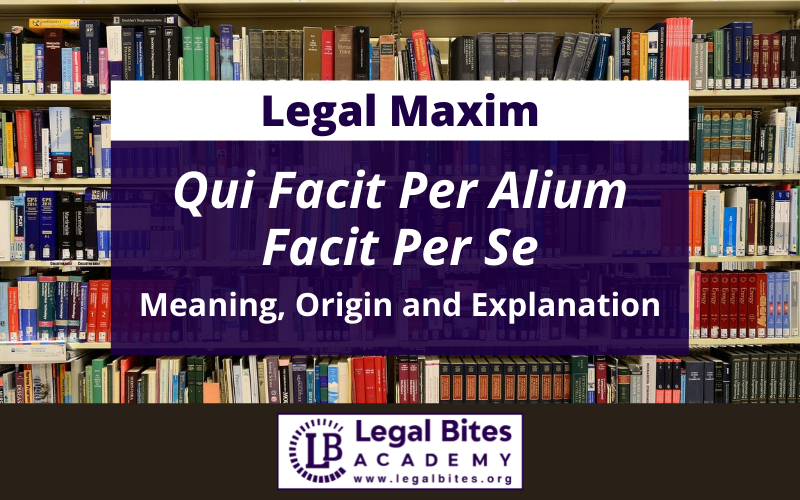Qui Facit Per Alium Facit Per Se: Origin, Meaning and Explanation
This article titled ‘Qui Facit Per Alium Facit Per Se: Origin, Meaning and Explanation’ is written by Sahajpreet Bhusari and discusses the legal maxim of Qui Facit Per Alium Facit Per Se. I. Origin and Meaning Qui facit per alium facit per se is a legal term of Latin origin. In Latin, it means, ‘one who acts through another,… Read More »

This article titled ‘Qui Facit Per Alium Facit Per Se: Origin, Meaning and Explanation’ is written by Sahajpreet Bhusari and discusses the legal maxim of Qui Facit Per Alium Facit Per Se. I. Origin and Meaning Qui facit per alium facit per se is a legal term of Latin origin. In Latin, it means, ‘one who acts through another, acts himself’[1]. II. Explanation The above maxim is analogous to the Latin maxim Respondeat Superior, which is a conventional vicarious...
This article titled ‘Qui Facit Per Alium Facit Per Se: Origin, Meaning and Explanation’ is written by Sahajpreet Bhusari and discusses the legal maxim of Qui Facit Per Alium Facit Per Se.
I. Origin and Meaning
Qui facit per alium facit per se is a legal term of Latin origin.
In Latin, it means, ‘one who acts through another, acts himself’[1].
II. Explanation
The above maxim is analogous to the Latin maxim Respondeat Superior, which is a conventional vicarious responsibility premise. It indicates that an employer is responsible for any actions taken by workers in the course of their tasks and obligations.
When an employee is entrusted by his employer to perform certain tasks on behalf of or in the absence of the employer or master, the employee or servant is free to make decisions based on the circumstances. The essential principle of agency law is this. This principle, however, does not apply to criminal law.
III. Application
The maxim is a common basis for vicarious responsibility, in which one party is held accountable for the wrongdoings of another. The law of vicarious responsibility is a rule of evidence expressed in the premise ‘qui facit per alium facit per se.’
When fulfilling their obligations, a master and corporation are accountable for their subordinates’ willful actions and torts that cause harm to others. Partners are held accountable for each other’s improper conduct performed in the usual course of business under the same legislation. They are all referred to as joint tortfeasors, and they’re all responsible for the same things.
IV. Case Laws
“In accordance with the adage Qui Facit Per Alium Facit Per Se, which means – he who commits an act via another in the eyes of the law, does it himself,” the Allahabad High Court declared in Deo Narain Rai and Anr. v. Kukur Bind and Ors[2].
A signature by a mortgagor’s authorised representative is sufficient. This is an ancient and well-known adage that, in my opinion, should prevail unless the Legislature expressly states that its application was meant to be excluded in the interpretation of a statute.
When a person permits another to sign for him, the signature of the person doing the signing is considered the signature of the person approving it under common law.
The Madhya Pradesh High Court concluded in Mannasingh and Anr. v. State that criminal law does not accept the notion of vicarious responsibility, and that the master cannot be held liable for his servant’s crimes unless the master aided them or there is any legislative provision to the contrary.
The maxim of qui facit per alium, facit per so, which states that whoever acts via another is assumed to act in person, is a Civil law theory that does not apply to Criminal Law.
References
[1]Qui Facit Per Alium Facit Per Se, Available Here.
[2] (1902) ILR 24 All 319.


